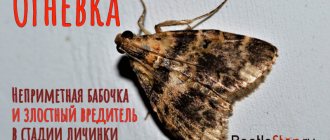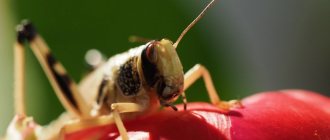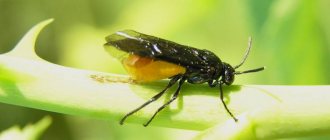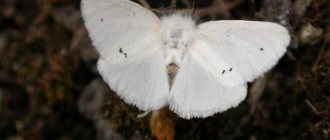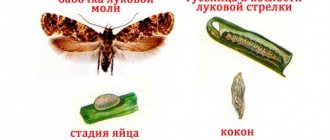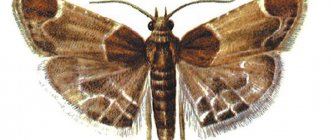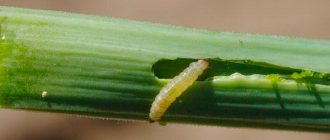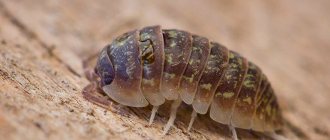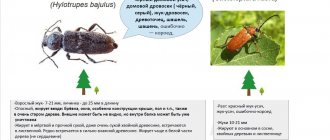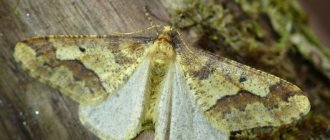- Wild animals
- >>
- Insects
Pied butterflies are a large family of motley butterflies, including over a thousand species and distributed throughout the planet except for permafrost lands. The moth butterfly has a calm character, even their flight itself seems sleepy and lazy - they are poisonous and have almost no fear of predators. They often become garden pests.
Social structure and reproduction
Photo: Pair of pied butterflies
Eggs are laid in the spring. The masonry can be either single or in rows. The eggs are about half a millimeter in size, they are elongated and yellow in color. It takes the caterpillar about a week and a half to hatch.
She has a kind of protection - she can pull her head into her chest. Her entire body is also protected: it is covered with bristles.
But much more important is that it is poisonous, which is why rare predators risk attacking it; most know very well that it is inedible
Having properly eaten and grown, the caterpillar goes to “winter.” This can be called this very conditionally, because wintering for them can begin in July, if these are caterpillars of the first generation, the earliest, or in August for subsequent generations. This is in temperate latitudes; in the tropics, new generations appear all year round.
They spend a lot of time hibernating until the next warm period. Then they wake up and again begin to devour leaves or buds, because it takes a lot of energy to turn into a butterfly. Having accumulated enough reserves, they finally pupate and then develop into adults.
Thus, more than a year passes from laying an egg to becoming an adult. The butterfly usually does not fly far, and reproduces in the same garden where it appeared - as a result, if measures are not taken against them in time, within a year the garden may be literally filled with them, which will not benefit its fertility at all.
Population and species status
Photo: Pied butterfly in Russia
In general, nothing threatens pied moths as a family - they reproduce rapidly, and where a couple of butterflies live, a few years later there may be a thousand. Even fighting them does not always help to completely get rid of these pests, but often only reduces their population to acceptable levels.
Thus, due to rapid reproduction, these butterflies are very tenacious. But there is another nuance - they do not spread evenly over a large area, but live in pockets, very densely. As a result, the complete destruction of several such foci can greatly reduce the range of the species, and if it was not widespread, then put it at risk.
Therefore, although many pests are much more widespread than people would like, and there are a lot of them, there are also rare species that are on the verge of extinction and are protected in certain countries or regions.
Interesting fact: There are about 18 thousand species of butterflies, also known as diurnal butterflies. This may seem like a lot, but there are many more different species - about 150 thousand species. Most often, moths are small in size and have a primitive structure, but the species diversity among them is amazing.
So, along with very small moths, these include Saturnia pear and Death's head hawk moth - their wingspan can exceed 150 mm. There are much more moths not only in the number of species, but also simply in quantity, and at night a simply huge number of lepidopterans lead their lives.
Folk remedies against cutworm butterflies
There are people who do not trust chemistry, believing that pesticides remain in the garden crops after treatment with insecticides. For them, it can be recommended to use folk remedies against the cutworm. But we must immediately make a reservation that their effectiveness is much lower than that of purchased insecticides.
There are many recipes for herbal solutions and home remedies, so only the most popular ones will be given here.
Sagebrush. To prepare the solution, take 1 kg of fresh wormwood leaves and stems and fill them with 3 liters of raw water. Then boil for 20 minutes and the solution is ready. You just need to wait until it cools down.
Hot pepper. Take 100 g of hot pepper pods, add 1 liter of raw water and boil for 40 minutes. Then they wait until it cools down and filter the solution. Before use for spraying garden crops, the stock solution should be diluted with water in a ratio of 1:8.
Onion. Chop a small onion head, add 1 liter of water and leave overnight. In the morning, the solution is filtered and used for spraying during the flight of butterflies.
Garlic. To do this, take 5 cloves of garlic, chop them and pour 1 liter of water into the pulp. It should be left for 3 days. Before use, the stock solution is diluted with water in a ratio of 1:5.
Burdock. The leaves and stems of burdock are finely chopped, placed in a container and filled with raw water. Leave the composition for 3 days, then add liquid soap at the rate of 30 g per 10 liters of liquid and begin spraying.
Tomato tops. 4 kg of fresh tops are crushed, and then 10 liters of water are poured. Then the composition is boiled for half an hour, cooled, and filtered. Before use, the mother liquor is diluted with water in a ratio of 1:3.
Henbane black. The greatest toxicity of this plant is observed during its flowering phase. It is at this time that you should chop 1 kg of the above-ground part of this plant and add 10 liters of water. After 12 hours of infusion, the solution is filtered and used for spraying cultivated plants.
Despite the fact that the moth moth is very harmful, it is not difficult to exterminate it. To do this, first of all, you should adhere to the preventive measures described above. When a pest is detected, you must immediately fight it, choosing the method of control that will be the most effective.
Types and differences: their descriptions and photos
The large cohort of moths can be divided according to their feeding habits:
- clothes or household - eats fabrics made from natural wool, spoils furs;
- food or grain - found in cereals;
- fruit or mushroom - feeds on dried mushrooms, nuts, dried fruits;
- waxy - settles in hives and natural bee houses (its larvae are used to prepare medicines);
- gardening and vegetable gardening – plant pests.
Apple moth: caterpillar and moth
The last representatives of these pest moths on the list lay eggs on the leaves, shoots and flowers of plants. The larvae cause significant damage to plantings by devouring leaves.
- Cabbage moth. It parasitizes all members of the cruciferous family. The gray or brown moth, no larger than 1.5 cm in size, is practically invisible in the garden bed. The larva has an excellent appetite, gnawing the leaf blade of the plant.
- The apple moth also affects other fruit trees (plum, cherry). An ashen-colored butterfly lays small clusters of yellow eggs on the bark of a tree. The larvae eat young leaves and plant buds. If the infection is severe, the apple tree may stop producing fruit.
- Rowan moth is dangerous not only for rowan, but also for apple trees. The small grayish butterfly is active at night. Its larvae feed on tree fruits, preferring rowan, but not disdaining apple trees. Fruits spoiled by moth larvae are not stored and rot.
- Potato is a quarantine pest that can destroy the entire crop of root crops. The butterfly parasitizes tomatoes, tobacco, eggplants and other cultivated plants. In appearance it is brownish-brown with dark stripes and streaks, with a wingspan of up to 20 mm. Very prolific, capable of producing up to 12 generations per season. Potato moth caterpillars feed on root vegetables, gnawing out the pulp. The potatoes are rotting.
- Spotted moth or leafminer. Affects tomatoes. Its larvae eat the leaves of the plant and in a short time are able to completely eat the bush down to the bare trunk.
Spiny oak slug caterpillar / Euclea delphinii
Experts note that the larva of this species of butterfly is not too dangerous, but during its evolution it has also developed protective mechanisms. They reach a length of no more than 1.5 cm, and feed, if you look at the species name of the butterfly, on oak leaves.
The body color is quite variegated. Throughout the body there are small outgrowths, at the tips of which a special substance is concentrated. Once in contact with the skin, this mucus causes a rash. These shoots are spiny. Touching them is quite painful. The touch is quite painful.
In addition to oak trees, such lumpy creatures can be found on willows and maples. She loves to eat both the leaves and fruits of garden trees, thereby harming agriculture.
Detailed description of the butterfly
It's called Pieris brassicae. It is part of the whitefish family, order Lepidoptera. The insect has become widespread in Eastern Europe, Africa, and Asia. The food source for cabbage whites is cruciferous plants, in particular cabbage. The insect is also found on other types of plantings: oilseeds, vegetable crops.
What does it look like?
The adult cabbage butterfly is quite large - the wingspan reaches 60 mm. A distinctive feature is light wings (white with small black spots and darkening at the base). The female is larger than the male. The imago (adult) lays eggs, the size of which is 1.25 mm. The caterpillar changes in size as it grows: from 1.74 to 60 mm. There are stripes on the body: light, yellow, and also hairs. The butterfly appears as a result of the pupation of a caterpillar. The cocoon is green-yellow, with black splashes.
The white butterfly can be seen in May, the next generation appears in July. The main task of the imago is to lay as many eggs as possible. The cabbage butterfly's food source is nectar from flowers. Insects fly for quite a long time - until October.
The rear element is marked with a black splash at the center of the front edge, and is colored yellowish below
Insect life cycle
There are several stages of development: pupa, imago, eggs, larvae. Cabbage white caterpillars develop over 40 days, then pupate, overwinter, and adults emerge in the spring. It takes 1-2 weeks for the developing insect to develop inside the egg. The butterfly attaches its offspring to the inside of plant leaves. During its life, the insect lays many eggs - up to 300 eggs.
You also need to find out how long the cabbage butterfly lives. The insect remains in adult form for no longer than 4 weeks. During the season (from May to October) 2-5 generations are replaced; the intensity of reproduction and development is influenced by living conditions. The colder the climate, the slower all processes occur.
What harm is done to a person?
Unlike the white butterfly, the larval form of insects is more dangerous. The caterpillar destroys plant shoots. First, the larvae live on the inside of the leaves, then move to the upper part. You can catch the cabbage butterfly caterpillar on cabbage, radish, and mustard. In addition, it is found on plants such as horseradish and turnips. This is the favorite food of such pests.
The main damage is caused to cabbage, but the pest also feasts on others: horseradish, turnips, radishes, etc.
In addition to the harmful effects on vegetation, the larvae create other problems. Thus, they secrete special substances that irritate human skin. The white caterpillar is also dangerous for birds; birds often die when they eat it.
A bright yellow caterpillar, 4 cm long, with 16 legs, lives for several weeks
Description of the insect
The Pestryanki family (Latin name - Zygaenidae) is part of the order Lepidoptera. It includes 1000 species distributed throughout the globe. But still, greater diversity is noted in tropical countries, where insects thrive due to the warm and humid climate. In the temperate zone of the European part of the former USSR, no more than 50 species are found. Many of them are garden pests because their caterpillars feed on the leaves of fruit trees and other plants.
Variegated butterflies (almost all species) have very bright colors. Their wings are usually black or blue with striking yellow, orange or blood red spots. Single-colored insects and those with pale coloring are rare. You can see what the moth butterfly looks like in the photo.
Such a noticeable appearance is given to pests by nature for a reason. Like most poisonous insects, the colorful coloring is a warning to potential enemies that you should not mess with the butterfly. She accumulates toxic compounds in her body, in particular hydrocyanic acid. Therefore, if insectivores try to feast on the pestle, they may, at best, face severe poisoning. Another way to protect against enemies is to secrete a strong-smelling liquid that also contains poison. Thanks to this, moths lead a quiet life, leisurely flying from flower to flower and feeding on sweet nectar using their proboscis.
Typically, the wingspan of pests is usually 4–5 cm. In the largest species, the Westwood pest (Elcysma westwoodii), it reaches 6 cm. This “giant” of the family is found in the Far East.
All moth butterflies have a long and developed proboscis, which is not covered with scales. In a small number of species it is reduced. The antennae located on the head can be spindle-shaped, comb-shaped and serrated. They are topped with maces. Insects of this family are characterized by the presence of chaetozema - a cluster of bristles on the head, which acts as an organ of sensory perception of the surrounding world.
Variegated species
- Grape moth is found mainly in regions located near the sea. The butterfly has dark green wings that glow bronze in the sun. Although the insect has a modest size (the wingspan is usually 2.5 cm), it is very dangerous for vineyards, which is why the species got its name. Its yellow-brown caterpillars, reaching a length of 1.8 cm, settle on the vines and feed on succulent fruits. leaves, causing great damage to the crop and the quantity of the harvest.
- Clover moth is somewhat larger - up to 3.5 cm in wingspan. Outwardly, it is very similar to meadowsweet. It has a wide habitat - from the north of the African continent to the west of Asia in the east and European countries in the north. The main “delicacy” of clover moth caterpillars is the horned lamb plant, as well as its closest relatives – alfalfa and clover. It waits out the winter cold in the form of a caterpillar, which, with the onset of spring, continues active growth and finally pupates. They are poisonous because hydrocyanic acid salts accumulate in their bodies. The butterfly's activity—years—occurs in the first months of summer.
- The purple moth is also a medium-sized butterfly, the wingspan of which is from 3 to 3.5 cm. Its caterpillars, which are in this development phase from approximately August to May, are fond of herbaceous spicy plants: thyme and thyme. The flight of moth butterflies occurs from June to July.
- Meadowsweet is one of the most common species. It inhabits Europe and Western Asia, sometimes living at an altitude of 2000 m above sea level. The length of the front wings is 2 cm, and the total span is about 4 cm. The species was discovered in 1758. The front wings are painted black with a metallic sheen. They usually have 6 (sometimes more or less) round spots of bright red color. Meadowsweet moth caterpillars are not particularly remarkable: they are small in size and have a dense body covered with hairs. Their color is usually faded green. Cyanide compounds accumulate in the caterpillars and therefore pose a mortal danger to insectivores.
The common pied moth is easily confused with the false pied moth because they are very similar in appearance. But the second belongs to another family of Lepidoptera - lat. Ctenuchidae. It has approximately 3000 species. The common false moth, like most butterflies, is diurnal and is active in June and July. These insects prefer to live in clearings in deciduous forests or in meadows nearby where there are flowering plants. They sit on them, feeding on nectar, in small flocks.
The wings of false pieds are dark blue, with white spots on them: on the front - 5 or 6, and on the hind - 2 or 3. A distinctive feature of the species is the white tip of the antennae, as well as the presence of a pair of yellow stripes on the abdomen, which are called bandages. Caterpillars are black, with brown ptosis. Dandelions and plantains are chosen as habitat plants, and less often other herbaceous plants. Therefore, unlike the caterpillars of true pests, they do not cause harm to human plantings.
How to deal with a pest
In gardens, it is necessary to regularly inspect fruit trees and berry bushes. Any discovered clutch of eggs must be scraped off and burned or buried to a depth of at least half a meter. Oviposition on the bark of old trees can be treated with a mixture of kerosene and mineral oil.
During the growing season, treat fruit crops with Virin-KSh and Virin-ENZh. Their active principle is viruses that harm the parasites, but are not toxic to humans and animals. The action of "Virin-KSh" is directed against silkworm caterpillars. One treatment is carried out at a rate of 200 ml per hectare. The drug "Virin-ENZh" is used to treat egg clutches at the rate of 0.02 ml per clutch.
Before bud break, trees can be treated with nitrafen or oleocuprite. Before flowering, trees are sprayed with insecticides: nexion, chlorophos, dursban, gardon, metathion, antio and others.
The hatched caterpillars are collected and destroyed. In the early stages of their development, treatment with the pesticide Bacillus thuringiensis, which is most active at an air temperature of 18–30 degrees, is effective.
To catch caterpillars, traps in the form of special adhesive rings are used, which are attached to the trunk and branches of trees. You can make a trap from a piece of burlap, which is wrapped around a tree trunk one and a half meters from the ground and secured with rope. The upper part of the fabric is folded over the rope. Caterpillars are collected daily.
It is very important to wear gloves to prevent skin contact with the poisonous hairs of the caterpillars. You can also collect and destroy insects in the pupal stage, when they pupate en masse, in large colonies, entangling themselves with threads
You can also collect and destroy insects in the pupal stage, when they pupate en masse, in large colonies, entangling themselves with threads.
Entomophages are involved in the fight - predatory insects (certain types of beetles and wasps), birds. For example, in relation to the ancient mothwort, the most active egg eater is from the genus Telenomus. Folk remedies include substances that repel pests, such as tobacco infusion, nightshade tops, and ash.
When butterflies emerge en masse, it is useless to fight them. During such outbreaks, in order to prevent the further spread of parasites, they even resorted to burning forests.
The life cycle of the corner wing and its strange features
1-2 generations of butterflies develop per year.
The first generation emerges from the pupae at the end of June, and this is where things get weird.
Most of the corner wings are representatives of the typical form, and about 1/3 belong to the light summer form. The latter are distinguished by the ocher color of the underside of the wings and their less rugged edges.
Butterflies of typical shape
- long-lived. They are active until late autumn, then hibernate, wake up in the spring and fly until early June, thus living for almost the whole year.
But butterflies of a light summer shape
, born in late June-early July, live only one month. Closer to September, butterflies of a typical shape hatch from the eggs they lay, which overwinter in the same way as individuals from the June generation.
Such a strange mechanism with two forms, the life expectancy of which differs by an order of magnitude. Why was this done? Unclear.
The female lays eggs one at a time on the leaves. The egg matures in about 5 days. The hatched caterpillars stay mainly on the underside of the leaves; sometimes they can make a shelter out of them, fastening the edges with silk. The caterpillar pupates, as a rule, on food plants. The duration of the pupal stage is 9-15 days.
Forage plants
Angler caterpillars: common hazel, gooseberries, hops, toadflax, honeysuckle, currants, raspberries, willow, elm, nettle.
Butterflies are very agile. At rest they sit on the leaves of trees or bushes, often with their wings folded. They can, with their wings spread, take “sunbathing”. Adults feed on the nectar of various types of herbaceous and shrub plants, fermenting tree sap and overripe fruits; they readily sit on moist soil along the edges of puddles and reservoirs, as well as on animal excrement, because. their development requires minerals that are difficult to obtain from nectar.
Angler and checkerwort feast on someone's excrement
So, if in the middle of the road you see a cluster of orange and black-spotted butterflies, be prepared for cognitive dissonance: they are not collecting nectar there.
Cabbage is a dangerous pest of cabbage heads
Pieris brassicae, wingspan – 45-63 mm
Cabbage grass, or cabbage white, is familiar to every summer resident. You can find it in beds with cabbage, turnips, turnips and other cruciferous crops. The butterfly is fussily looking for a place to lay eggs, from which yellow-green caterpillars will soon appear. During the season, one individual lays up to 300 eggs!
Unprepossessing in appearance, the white hare terrifies with its appearance. You should especially be wary of females, the main difference of which is the black spots on the upper wings.
The voracious caterpillars of the white butterfly eat the leaves and prevent the head of cabbage from forming. After a while, only the veins remain from the leaf. When the food runs out, the pests crawl to new plantings.
How to deal with cabbage and its caterpillars. Safe methods include hand-picking caterpillars and catching butterflies. You can also plant marigolds, marigolds, mint or sage between the rows, which will repel pests. A good way is to cover the cabbage with a mosquito net and agro-canvas so that butterflies cannot lay eggs. Folk remedies will help by spraying 2 tbsp. mustard and 1 tsp. ground red pepper per 10 liters of water. And if there are a lot of insects, use Fitoverm, Karbofos, Actellik or another insecticide.
What are the 2 most dangerous butterflies that live in Europe?
The most dangerous butterflies for humans that live on the European continent include the goldentail and the common bear. The goldtail has white translucent wings and is unremarkable in appearance. However, both its caterpillar and butterfly have hairs, upon contact with which a person can get an allergic reaction.
The butterfly lives everywhere, right up to northern Finland. There are especially many of them on the Mediterranean coast, which is rich in forests and parks. Tactile contact with lacewings leads to an allergic reaction.
The common bear can be found in Russia, the Caucasus and the Urals. She has an interesting color of her wings: the front ones are white with brown spots, the back ones are orange with black spots. The bear's body is shaggy, as if the beauty was wearing a fur vest. And this “vest” causes trouble for people and animals who dare to get closer to the beauty. The corpuscle villi cause an allergic reaction. And if the lint gets into the eye, then conjunctivitis occurs.
In Russia, one of the most dangerous is the common bear.
Appearance of the insect and stages of development
Like butterflies, moths and moths, this pest belongs to the order Lepidoptera. Description of appearance:
- The length of the wings is from 22 to 25 millimeters, their span is from 43 to 50 millimeters;
- Thick, cone-shaped body;
- The fore and hind wings are covered with chitinous scales;
- The body consists of three main sections: head, chest and abdomen;
- With the help of long antennae, which are sensory organs, they are able to perceive vibrations and smells;
REFERENCE: Sex differences are clearly visible in these pests. Males have more developed wings, females have smaller ones, and sometimes they don’t have them at all. The moth has a full development cycle.
- Has a light color;
- There is a pattern on the wings - black dots and longitudinal stripes;
- They are nocturnal.
Its stages of development:
- Egg;
- Larva (caterpillar);
- Pupa;
- Adult (imago).
Birch moth caterpillar:
Description of pests
The size of eggs of pests is 0.4-0.6 millimeters. The shape is oblong. The color is yellow with a characteristic mesh pattern. The eggs of some species of pests are covered with scales.
Many pied caterpillars secrete protective secretions - products of amino acid metabolism. Viscous secretions are stored in special cavities located in the cuticle.
Adult moths are small to medium in size. The wingspan averages 4 centimeters.
An exception is the species Elcysma westwoodii; the wingspan of these butterflies is approximately 6 centimeters.
The proboscis of pests is long, well developed, without scales. But in some species the proboscis is reduced. There are short labial and maxillary palps. The antennae on the head may be serrated, comb-like, or fusiform. The color of the antennae is green or blue with a metallic sheen. When at rest, butterflies fold their wings like a roof.
What harm does it cause?
Cutworms have long been considered dangerous pests of various crops; some species are classified as quarantine types. These are bollworms, meadow cutworms, Asian cottontail cutworms, cabbage cutworms and Finnish cutworms.
To completely destroy 10 plants overnight, only 2-3 to 7-8 caterpillars of different species are required. Therefore, the damage caused by cutworms is colossal and amounts to up to 100% of the entire harvest.
Some species are also barn pests. Once in storage, they do not die, but continue to feed on the grain placed in storage. To such types of cutworms as grain and ordinary grain, dry grain seems no worse than fresh grain.
It should be borne in mind that the better the living conditions, the more fertile the females, the more active the caterpillars, the faster the destruction of poor plants occurs. The greatest damage is caused by the older caterpillars of the latest generations.
Ways to combat pestra
In agriculture, the following scheme for controlling pests, which involves the use of chemicals, is considered optimal:
- When the buds swell, the trees are sprayed with the insecticide DDT (dichlorodiphenyl trichloromethylmethane) at a 5.5% concentration or hexachlorane (12%).
- After bud break, these drugs are reused.
- In mid-summer, when new caterpillars have emerged from the eggs, only DDT is applied. To ensure that the crop is safe for consumption, the procedure can only be carried out 30 (or more) days before harvesting.
The use of biologically active drugs will also be effective: for example, Entobacterin and Dendrobacillin. If the air temperature is less than 25 °C, then they must be used in combination with pesticides. For example, with products containing organophosphorus components.
Speckles are a dangerous enemy of the garden and vegetable garden. They spread very quickly throughout the area because they prefer not to fly far from their habitat. The use of chemical and biological drugs, which must be used in accordance with the scheme and safety rules, will help drive them out.
Measures to control armyworm pests
How to fight cutworm butterflies using agrotechnical methods, biological and chemical means?
Agrotechnical methods. Compliance with quarantine measures helps prevent new species of lepidoptera from entering greenhouses. The arrival of native butterfly species can be controlled using light traps and pheromones. Caterpillars are mainly controlled through integrated control, combining biological methods with the use of selective pesticides or other methods.
Biological agents. Bacterial preparations based on Bacillus thuringiensis are most effective against young free-living caterpillars. For example, Macrolophus, are not specialized predators, however, they help fight them. The bug sucks the contents of eggs laid by butterflies and young caterpillars. This, with a high number of predators, makes it possible to refuse treatment with pesticides. In the fight against caterpillars, predatory insects specially bred for this purpose can be used: Podisus maculiventris and Picromerus bidens L.
Chemicals. Preparations based on deltamethrin (Biorin and Fas), which have a rapid and very toxic effect, are recommended. Due to the large difference in the time when caterpillars hatch from eggs, plants should be treated at intervals of 5-7 days in 3-4 times. The use of modern drugs from the group of neonicotinoids (Aktara, Konfidor), which have a systemic and translaminar effect, facilitates the fight against pests that feed on plants at night and inside fruits. To prevent the emergence of resistance, it is advisable to alternate treatments (organophosphorus or microbiological preparations).
Using such measures to combat cutworms, it is necessary to dust the soil surface (along the rows and under the plants) with 12% hexachlorane powder. In autumn, the area intended for planting must be treated with hexachlorane. This anti-owl preparation is evenly dispersed on the soil surface, then embedded to a depth of 20–25 cm. The consumption rates of 25% hexachlorane powder on phosphate rock per one hundred square meters are as follows: for light soils – 350–500 g, for medium soils – 500–1250 g, for chernozem, heavy loamy soils - 1250–1500 g. When using 12% powder, the consumption rate should be doubled.
Available means of control
To destroy armyworms and their caterpillars, a set of measures is required throughout the growing season. It should be aimed at all stages of development, including adulthood. The intensity of the agents used depends on the degree of damage to the green mass and fruits in the area by the cutworm.
Folk remedies are effective as preventive measures even with a small number of larvae. Pesticides are used when the reproduction of larvae threatens the harvest of vegetable and fruit crops.
Specialized means
Effective biological pesticides have been developed against leaf-eating larvae.
Bacterial insecticides based on Bacillus thuringiensis:
- release form – dust, wetting powder, concentrated suspension;
- active ingredient – aerobic bacteria Bacillus thuringiensis;
- mechanism of action - intestinal toxicosis for 1-4 days (in the first stage - indigestion, in the second - germination of spores; in the third - death);
- non-toxic to bees, fish, birds, animals and humans;
- acceptable for use in chemical and bacterium mixtures.
The drugs are produced in packaging for homesteads and farms.
The use of trichogramma (entomophages) in the fight against enemies of agricultural crops is becoming increasingly widespread in all countries. The predatory bug is a natural enemy of cutworm larvae. Artificial colonization is used to kill worms in greenhouses. It was not possible to acclimatize the heat-loving subsus in the natural environment.
In the biological laboratories of agricultural complexes in the Moscow region, the picromerus bug, a hunter of eggs and larvae of leaf-eating insects, is bred. As bioprotection, predator larvae and eggs are used, which are “planted” on the leaves using an adhesive mixture. The natural range of picromerus is northern Europe, including Russia.
Pesticide:
- Dacis Pro. The active substance, deltamethrin, has a nerve-paralytic effect on gnawing cutworms. Method of application: spraying during the growth period of vegetable crops.
- Avant. The active component, indoxacarb, blocks the functioning of the digestive system of lepidopterans.
- Karate Zeon. The base is an isomer of the pyrethroid cyhalothrin. It has intestinal, contact, residual, repellent properties. It is used for the protection of agricultural crops and disinfestation of granaries. Toxic to bees, fish and other reptiles.
Pesticide treatment is carried out in calm, dry weather at temperatures up to 20 degrees. For complete destruction, additional disinsection is carried out.
Folk remedies
The cutworm can be controlled without the use of biological or chemical drugs, if the number of moths and larvae has not reached a critical value.
Methods of counteraction lie in the peculiarities of the species behavior of adults and intermediate individuals:
- Creation of obstacles for arrival. You can achieve results by planting on the site that repel cutworms with the pungent smell of wormwood and tansy.
- Removal of wild plants, especially weeds. Weeds blooming between rows serve as bait for moths feeding on flower nectar. They lay clutches of eggs on them, from which the larvae crawl throughout the area.
- Destruction of eggs and larvae by deep loosening of row spacing.
- Lack of access to hollows where pests can overwinter: plugging the openings with cement mortar with the addition of lime and copper sulfate.
- Catching moths using light traps: at dusk, turn on a powerful lamp. The brighter the light source, the more moths will arrive.
- Collecting worms at night using a flashlight while examining the plantings.
- During the mass summer, an exhibition of baits (small containers with honey dissolved in water).
- Placing cornmeal in places where worms accumulate, which they cannot digest.
Plantings can be sprayed with a soapy solution of wormwood and tansy. Finely chopped stems, leaves and flowers (300 grams) are poured with boiling water (10 liters) and left for 5 hours. Then liquid soap is added at the rate of 30 milliliters per 10 liters, a glass of ash, mixed and immediately used for processing.
Natural enemies of moths
Photo: Pied butterfly in nature
Due to the poisonous nature of the pest, the pest has relatively few enemies, both in the form of a caterpillar and after transformation into an adult. Most predators are repelled by its color or the smell of the substance that it releases when it is in danger - both of which indicate inedibility.
But still, some predators can digest such butterflies and hunt them. The list of enemies of the pest can vary greatly depending on what species it belongs to, but most often it includes:
- ground beetles;
- coccinellides;
- spiders;
- predatory bugs;
- syrphid fly larvae.
Those listed above are not afraid of the poison of the moth, but they most often hunt for its eggs and caterpillars, and the imago can feel safe - only large tropical spiders can threaten it.
An important enemy of pied moths, most likely even the worst, is people. Due to the fact that pests are garden pests, and very malicious ones, they are purposefully fought with the help of chemicals, which destroys large numbers of them, and sometimes even entire populations.
Features of character and lifestyle
Photo: Pied Butterfly
Most moths fly actively during the day and rest at night. Although there are exceptions - some species fly at night, like other moths, they tend to fly towards lanterns and into illuminated windows. Most often, moths love sunlight and warmth; they can often be seen basking in the rays, with their wings folded.
The design of their wings is quite primitive - this is due to the fact that they are not usually hunted in the air, and therefore pied moths did not have as many incentives to improve their wings as most other butterflies. As a result, they fly very slowly and their flight looks clumsy.
A caught moth may pretend to be dead. The level of fearfulness varies depending on the species - some pieds, until obvious aggression is shown towards them, are generally calm, allow people to freely take control of themselves and do not even try to fly away.
Such a calm character was largely developed due to the fact that they are threatened by quite a few dangers, and there is no need to be afraid of every rustle - an ordinary butterfly cannot afford such calmness, because every minute, even right in flight, birds can hunt for it .
The life of pests is calm and measured: when the sun comes out, they fly out to feed on flowering plants, slowly flying from one to another, usually close to other pests, in whole groups. In general, they are not inclined to move far and can spend their entire lives in one garden or in one meadow.
Varieties
Volyankas include:
- willow grass;
- heather brushtail;
- reed grass;
- antique brushtail;
- bashful fur-footed;
- Volyanka el black;
- gypsy moth;
- dark wave;
- goldentail;
- yellowtail;
- coniferous woolfoot;
- Volyanka dissimilar, etc.
Willow
Distributed everywhere - from Europe to southeast Siberia and east Asia. At the beginning of the last century it was brought to North America. Large outbreaks of mass reproduction are periodically observed.
This beautiful snow-white butterfly with silky shiny wings, during mass reproduction, is capable of completely denuding poplar and willow plantings in the spring. The wingspan is from 30 to 40 mm. The chest and belly are white. The eyes are black, the legs are striped, black and white. The antennae of the female are short-combed, while those of the male are bilaterally combed.
The caterpillar grows up to 45 mm long. Each segment of the body is decorated on top with a white spot and six brown-red warts studded with hairs. Two more black warts are located on the fourth and fifth segments. The size of the pupa covered with golden hairs is from 13 to 22 mm. Color – black-brown. At the strongly narrowed end of the abdomen there are hooks.
The emergence of willow grass occurs in June-July. The butterfly is active in the evening. Females lay two hundred eggs on the bark of willows and poplars and cover them with foam, which dries quickly. After two weeks, the caterpillars hatch from the eggs and begin to skeletonize the leaves. As they grow older, their appetite increases. The caterpillars overwinter separately in cracks in the bark, entangling themselves in a web. They return to active life in April next year. They pupate in June-July. The insect remains in the pupal stage for about 10 days. In the south there is double generation. Under unfavorable conditions, the eggs overwinter, and the caterpillars appear only the next year.
Antique (common brushtail)
Habitat: Europe and Asia. In Russia - in the European part, in Siberia, the Urals, the Amur region, Southern Primorye, and the Caucasus.
The male's wings are rusty-brown in color, with one white spot on the front wings. Swing – up to 30 mm. The female is wingless. The gray caterpillar is covered with red hairy warts. At the posterior end of the body, the hairs are collected in a black brush (hence another name for the butterfly - the antique brushtail). The caterpillar feeds on oak, birch, and larch needles. May harm ornamental trees. In warm weather, in well-warmed, thinned forests, outbreaks of mass reproduction of the butterfly are possible, lasting up to 7 years.
The female lays up to 360 eggs on her cocoon, which easily overwinter even at forty-degree frosts. In spring, when temperatures change, they often die. Generation: in Siberia - annual with emergence in August-September, in the European part - double, emergence in July-August and September.
gloomy
Habitat: south of Primorsky Krai, Japan, Northeast China. It settles in pine, oak and apricot forests on limestone rocks in places where hard juniper grows, which is the only food for the caterpillar. The wingspan of the male is about 25 mm, that of the female is about 30 mm. The front wings are brownish-gray with a faint pattern in the form of two black strokes at the base of the wing and a wavy band along the edge. The hind wings are slightly lighter than the front wings, the same color as the belly. The chest and head are dark gray. Butterflies are active in the second half of summer. They can be found at dusk near juniper trees. The life cycle of the gloomy moth has not been studied. The species is listed in the Red Book of Russia.
Unlike
Habitat in Russia is exclusively Primorsky Krai. Also lives in China, Japan, and the Korean Peninsula. The butterfly can be found on mountain slopes in mixed coniferous and black fir-deciduous forests. Males and females are very different from each other. The wingspan of males reaches 46 mm, in females - 55 mm. The color of the male's wings is velvety black. There is an oblique white stripe on the front wing. The female's wings are elongated. The black front ones have three wide white veins in the form of a fork. Another vein is located at the base of the wing. On the hind orange-yellow wings there is one blurry black spot.
Females are active at night, males fly during the day. Summer begins in July-August. The eggs overwinter. The caterpillars emerge from the eggs by the end of June. They feed on Manchurian hazel and heartleaf hornbeam. On the same trees, the caterpillars pupate for 10–12 days. The dissimilar moth is a rare butterfly that is endangered and is therefore listed in the Red Book of Russia.
Harmful species of moths
The moth family has more than 23,000 species. About 2,500 live in the CIS. Among them there are many pests that eat up the vegetative and generative parts of plants, thereby worsening their growth, development, and fruit quality.
Pine moth
It lives everywhere where there are plantations of coniferous trees. The pine moth has the same body structure as all representatives of this family and is distinguished by its color:
- males are dark brown, have small patches of white or yellow on the wings and a large triangle at the base;
- the wings of females are rust-colored with yellow spots;
- a young caterpillar of green color with a yellow head, its size does not exceed 3 mm; as it matures, it acquires a yellow-green color with white longitudinal stripes and grows up to 3 cm;
- The green pupa is 12-14 mm long and turns dark brown at the end of the pupation stage.
The caterpillars feed on pine needles; in their absence, they do not neglect cedar, fir, and spruce. In dry summers they begin to actively reproduce and can destroy large areas of coniferous plantations. After an invasion of pests, trees lose their crown, weaken, dry out and are of no value to industry.
One pine moth caterpillar eats 3.5 kg of needles.
Mating begins in early summer. The female lays 28-30 eggs in rows, 4-7 eggs in each.
Moth was ripped off
The moth is not very picky about what it eats and happily harms all fruit trees.
Rose hips, willow, hazel, blueberries, and birch are not ignored. What does the gluttonous look look like:
- male with straw-yellow wings with black dots, wingspan reaches 5 cm, willingly flies into the light; years begins in mid-September;
- females without wings, white body with black spots; while the male is flying, he crawls up the trees closer to the top and lays yellow eggs under the buds;
- brown or yellow caterpillars emerge from eggs in April and eat the buds, causing damage to orchards.
A female moth can lay from 200 to 800 eggs.
Green moth
The green moth is quite large in size. The wingspan is 45-50 mm. Newly pupated butterflies are distinguished by their rich green color with transverse white stripes. As they age, the color of the wings fades.
It lives throughout Europe in bushes and forests. Prefers hazel and birch, but does not neglect other deciduous trees. The young caterpillar is brown, 25-30 mm long. Overwinters in the soil, under the bark. In spring it turns green with brown spots - reminders of the old color.
Moth tailed
Widely distributed in western Eurasia. The tailed moth has a distinctive feature - small tails on its hind wings. The young butterfly is lemon yellow in color, which quickly fades to cream. The caterpillars are brown with characteristic protrusions in the form of knobs.
It is rare to see the moth moth, due to its short life cycle. The short summer begins at the end of June and ends at the beginning of July.
Gooseberry moth
Lives everywhere, with the exception of northern latitudes. The gooseberry moth is distinguished by the original coloring of its wings, which varies from white to rich yellow shades. The pattern is variable and most often represents a wavy line on the front wings.
It feeds on the leaves of bushes. Before pupation, the caterpillar rolls up the leaf into a tube, securing it with a web.
Butterflies are active not only at night, but also during the day. Their flights are observed throughout the entire summer period.
Sorrel moth
The butterfly is not distinguished by its large dimensions and colorful coloring. The wingspan is 20-25 mm and has a nondescript beige color with a crimson edge. The sorrel moth prefers damp areas and feeds on buckwheat plants, sorrel, and knotweed.
Two generations appear in a year. The caterpillars are dark purple in color and have a light stripe on their back. The color of the pupa is grayish-brown.
Clover moth
Color and shape are very variable, due to its wide range. The background of the wings varies from white to yellow. There are 2 regenerations per year. The clover moth is found mainly in meadows and fields.
Flower moth
The flower moth affects barberry, hawthorn, thorn, and fruit trees. The color of the front wings of the butterfly is gray, brown with brown stripes and dark spots. It overwinters in the pupal stage, from which a light green caterpillar with a red dorsal stripe emerges. They chew out leaves and holes in flowers.
Flower moths can destroy 25% of foliage.
How to protect your garden from other pests
This section of the article describes how to protect your garden from pests such as moths, slugs and bean aphids.
Moths.
People call moths moths. These are insects belonging to the butterfly family, which has 2,000 genera and more than 23,000 species.
As you can see in the photo, these garden pests have a weak, thin body and wide wings, the span of which reaches an average of 15-40 mm:
The flight of butterflies occurs mainly at night, but some fly during the day. The pest's caterpillars are colored to match the color of the bark and leaves, which gives them the opportunity to camouflage themselves as petioles and broken twigs. They feed on the leaves and ovaries of pear and apple trees. In addition, caterpillars have false legs, which gives the impression that when insects move, they measure the distance they travel with a span. Hence the name of this pest.
Slugs.
These pests cause significant damage to strawberries, as they infect the berries, eating away the pulp. The greatest activity of the pest is observed during rainy summers, when there is a high probability of formation of damp, shaded areas on the site. Slugs live under various shelters - lumps of earth, old boards. This is where they lay their eggs. The pest is afraid of light, so it leaves its shelter at night.
The main methods of combating slugs include agrotechnical ones. To protect the garden from these pests, first of all, it is necessary to carefully cultivate the soil, removing weeds that create a favorable microclimate for the development of the pest. In addition, small grooves near the plantings with ash, lime, ground hot pepper or tobacco dust sprinkled on their bottom can be a good help for the gardener. On the way to the plants, the slugs will climb into these grooves, but will not be able to get out of them.
Damage caused
The pests cause great damage, causing crop losses, in the spring. The caterpillars of these butterflies eat the buds when they begin to swell. The mass reproduction of pied moths is focal in nature, since these butterflies almost never fly over long distances.
Most often, harm to gardening is caused by the apple silver moth, which damages apple trees, pears and dogwoods.
Despite their beautiful appearance, pests are considered pests, as the caterpillars eat tree buds.
Also harmful is the white-spotted pocket moth, which causes damage to plum, pear, cherry plum, rowan and cherry. The leaf miner moth can lead to large yield losses.
If you find an error, please select a piece of text and press Ctrl+Enter.
NETTLE LOVERS
After 7-10 days, black caterpillars with light specks and spines emerge. The larvae of the moth wing are monophagous. They feed only on two types of nettles: stinging and stinging nettles. At first the caterpillars live in groups, but after the fourth molt they disperse. 5-8 individuals can feed on one plant. If they are startled, they fall to the ground.
Females are known to lay eggs on the emerging flower heads of the cowvetch plant. The timing is such that when the larvae appear, they can attack the newly opened flowers. These butterflies reproduce only once. Silver-blue butterflies are found in open woodlands, flowering meadows, roadsides, and sometimes in small waste areas in urban centers. It is abundant in areas that are near larval plants, as the adults also feed on the nectar of these plants.
In Canada, the Silver Blue is one of the most abundant butterflies and is found in every province and territory except southwestern Ontario, where it is relatively rare. Common and well distributed throughout England, Wales and Ireland, Isle of Man and Channel Islands. More restricted to predominantly coastal habitats in northern England and Scotland. Habitat: Frequently found in open grassy habitats including soil, railway banks, gardens and woodland attractions, but perhaps most commonly found in well-drained rabbitgrass grasslands, mature sand dunes and heathland.
A month later, the caterpillars pupate on nettles or in some kind of shelter, attaching to it with the tip of their abdomen. The pupa is dark brown, with dark spots at the wing buds. Soon the second generation butterflies emerge. But sometimes the pupae of spring moths remain overwintering together with the offspring of the summer form. However, in April, red butterflies still emerge from them.
Description: Medium sized black moth, red markings in foreground, rear edges mostly red. Often found near common ragworts, although occasionally on other disturbances and shellfish. This species is so named because of the color of the hind wings and the markings on the front wings, which make it unmistakable. In rare cases, the pinkish markings are replaced by yellow, or the front is red with a black border, or the wings are completely black. Easily disturbed during the day and flies into the sun.
Red soldier beetle - Ragonycha fulva
Description: A medium-sized black moth with six red, sometimes yellow, spots. In addition, some rooms also had Soldier Bugs. The red and black coloring reminded people of the red coats of British soldiers, hence the common name. It is also known as "Bloodsucker" for its bright red appearance, but it is harmless to humans.
To attract attention to endangered and rare species, an action is being held: a butterfly is announced - the symbol of the year. In 2007, it became the Variable Piedwing.
Toxic pest
In the photo, two butterflies drink nectar using their long proboscis. These are meadowsweet moths ( Zygaena filipendulae
), a fairly common species in Europe. Although these butterflies are small (their wingspan is 33–38 mm), they are very beautiful: just look at this metallic shine and bright red spots!
Meadowsweet moths. Photo by Yulia Mikhnevich, Belgorod region, July 28, 2022.
As often happens, such a bright color indicates the poisonousness of the butterfly and is called warning or aposematic. Cyanogenic glycosides accumulate in the body of these butterflies, the same ones that are why you should not overuse bitter almonds, apricot kernels, cherries and other stone fruits. When they interact with enzymes in the digestive system, toxic hydrocyanic acid, or hydrogen cyanide (HCN), is released. The larvae of pests feed on plants of the legume family, primarily the horned sweet potato ( Lotus corniculatus
), from which cyanogenic glycosides are extracted. This specific accumulation, storage and concentration of plant substances in the insect’s body is called sequestration (see Pyrrolizidine alkaloid sequestration). Glycosides are stored in the integument and hemolymph of butterflies. When a predator (for example, a bird) grabs an insect, cyanogenic glycosides come into contact with the enzyme β-glycosidase (see Beta-glucosidase) directly in the hemolymph or already in the intestine of the predator, where they are hydrolyzed to release hydrocyanic acid. You won’t want to eat such crap a second time.
The meadowsweet caterpillar stores glycosides in the cuticular cavities and secretes them when stimulated in the form of sticky droplets (highlighted in white circles).
).
The length of the scale bar
is 2 cm. Photo from the article NB Jensen et al., 2011. Convergent evolution in biosynthesis of cyanogenic defense compounds in plants and insects
At least 45 species of moths of the moth family accumulate the cyanogenic glycosides linamarin and lotaustralin. Moreover, it is interesting that their ratio changes during the life cycle of the butterfly and is strictly regulated. For example, the maximum concentration of both glycosides is observed in the seventh instar larva, and their ratio is one to one. Further, their number decreases by approximately 55% during the transition from the last larval stage to the imago (adult insect). Most likely, this is due to the fact that during metamorphosis, chitin is synthesized (the cocoon of the pupa and the cuticle of the imago are made up of it), which requires a lot of nitrogen. This nitrogen is partly taken from accumulated glycosides. In adult moths, the ratio of linamarin to lotaustraline is already two to one.
But what is surprising: pests are able to synthesize (in the integument) these substances characteristic of plants themselves! From the amino acids valine (linamarin) and isoleucine (lotaustraline) along the same path as in plants (this is convergent evolution, different genes are responsible for this). And, it seems, these are the only known insects capable of sequestering from plants and independently synthesizing the same cyanogenic glycosides.
However, cyanogenic glycosides are used not only for protection, but also for communication. Virgin females secrete hydrocyanic acid, and in a much larger volume than those that have already mated, thereby attracting males. At the same time, females evaluate the physical qualities of the male by the amount of cyanogenic glycosides (the more, the better). What’s even more interesting is that during mating, which lasts 16–24 hours in pied moths, the male gives the female a nuptial gift - a spermatophore with sperm, proteins and... cyanogenic glycosides. In general, spermatophores with plant substances are also transferred to females by male bear butterflies Utetheisa ornatrix
and
Cosmosoma myrodora
, butterflies from the nymphalid family
Danaus gilippus
, and nine species of the genus
Heliconius
. It is believed that such a gift helps protect the female and the eggs she lays from predators. But wait: if female moths themselves can synthesize cyanogenic glycosides, then why do they also need a gift from the males? The fact is that the synthesis of glycosides is very expensive - this is evidenced by the fact that caterpillars of meadowsweet moth on plants that do not contain cyanogenic glycosides develop much more slowly than on those containing them. So, perhaps, for females who spend a lot of glycosides on laying eggs (glycosides are not synthesized on their own in eggs), an additional gift is not at all superfluous.
Mating meadowsweet moths. Photo © Nick Goodrum from flickr.com, UK, 24 July 2016
Females lay eggs in mid-summer, usually on food plants and the larvae hatch within 1–3 weeks. The larvae have seven instars and moult every 8–10 days. The larva meets the end of summer in the fourth instar, after which a period of diapause begins until spring. Upon emergence, the larva feeds again, reaches the seventh instar after 4–6 weeks, spins a cocoon and pupates, and after 14–20 days the adult hatches. Adults live up to three weeks, during which time females and males need to find each other and mate, and females need to lay eggs shortly after mating. And the cycle repeats.
And, for starters, the main question. But how come the larvae themselves are not poisoned by hydrocyanic acid when eating the leaves of food plants? The fact is that in the plant itself, cyanogenic glycosides and the β-glycosidase enzymes that hydrolyze them are spatially isolated from each other, and they come into contact only after tissue damage by herbivores or pathogenic fungi. The intensity of hydrolysis of glycosides depends on the degree of tissue damage and the time available to the enzyme for hydrolysis. Therefore, the caterpillars of the meadowsweet moth eat legume leaves very quickly, at a speed of 3.8 cm2 per hour, while minimally damaging the plant tissue (the morphology of the lower jaw allows them to do this). The larvae cut off large enough pieces of leaf that match the size of the jaw, rather than chewing them, while maintaining the integrity of the plant cells.
Meadowsweet moth larva on a food plant ( A
) and details of its oral apparatus (
B
).
Shown are two partially overlying jaws ( mandibles;
photo
C
shows one jaw) and an upper lip (
labrum
);
the dotted line
is the leaf processing area.
D
and
E
show ingested leaf fragments in the larval intestine at different scales . It can be seen that they are quite large and approximately correspond to the size and morphology of the jaws. Photo from the article S. Pentzold et al., 2014. The Multiple Strategies of an Insect Herbivore to Overcome Plant Cyanogenic Glucoside Defense
Studies have shown that only 1.1% of the total amount of glycosides consumed is hydrolyzed during food intake. This is much less than that of other insects that feed on glycoside-containing plants. The alkaline environment in the intestines of pests inhibits the hydrolysis of glycosides with the formation of hydrocyanic acid. And the insect’s own glycosidases, found in the saliva and intestines, do not hydrolyze glycosides (but they hydrolyze in the hemolymph, as we remember). But the prussian can convert the prussic acid released in small quantities into the harmless amino acid asparagine. This is such a miracle insect.
Photo by Yulia Mikhnevich, Belgorod region, July 28, 2022.
Yulia Mikhnevich
